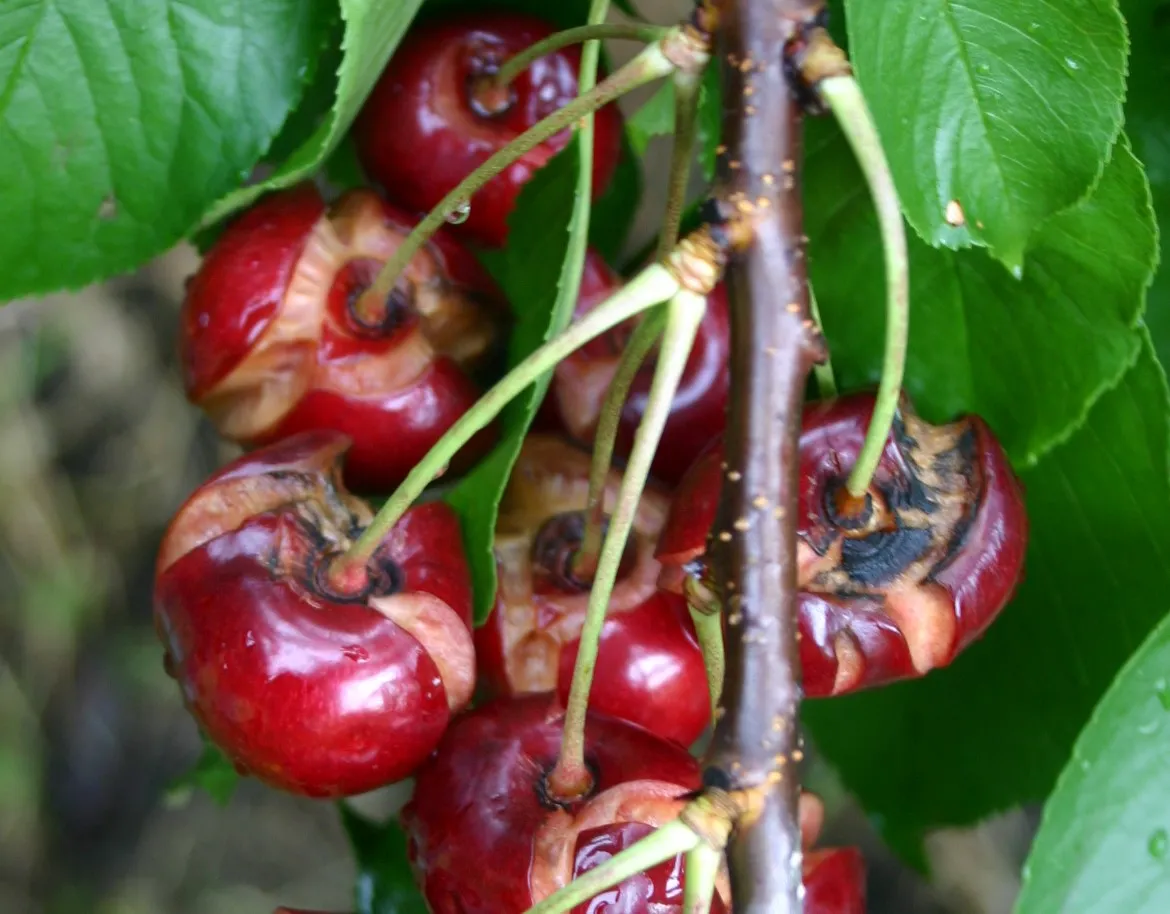This bacterial disease causes severe damage, and the Santina variety has shown to be highly vulnerable, particularly in developing orchards on limiting soils, conditions that are now recurring.
Bacterial canker, caused by Pseudomonas syringae, has long been a threat to cherry production in Chile. This disease compromises the development and productivity of orchards, especially affecting certain varieties and/or more susceptible orchards.
Among these, the Santina variety has shown high vulnerability, particularly in developing orchards located in areas with lower vigor or with limitations such as low-fertility soils, high stoniness, drainage problems, and biotic or abiotic stress.
Pseudomonas syringae and Santina's vulnerability
The team at Abud & Cía. has observed in the field the significant impact of this bacteriosis, which causes severe damage and represents a major challenge for growers, especially considering that the highest concentration of developing cherry plantations currently corresponds to Santina, in very diverse edaphological conditions.
Although all cherry varieties can be affected by Pseudomonas syringae, Santina has demonstrated particularly high susceptibility. Recent research indicates that, after infection by P. syringae pv. syringae, this variety activates defense-related gene expression more rapidly compared to others, like Bing.
However, this response does not seem sufficient to stop the progression of the disease, suggesting that additional factors, such as the physiological state of the plant and environmental conditions, play a crucial role in symptom manifestation (Vanneste, 2017).
Recent attacks and symptoms
During the past two seasons, a very aggressive attack has been recorded - in a significant number of developing Santina orchards - associated with Pseudomonas syringae. This manifests as “sudden death” or collapse of plants that, although appearing in good condition, experience bud, shoot, and wood death during budding, ultimately causing the death of the entire aerial part.
Although this phenomenon is not new and has already been observed in young orchards in previous seasons, the percentage of affected plants is surprising, which in the most extreme cases can reach between 10% and 30% mortality. This level of damage represents a significant loss in earliness, health, and the productive potential of the orchard once it reaches full production.
Critical factors in the “sudden death” of cherry trees
Three critical factors stand out as main causes of this problem: pathogen pressure during post-harvest, winter frosts, and stress. We will examine the main management strategies to reduce symptoms and minimize the incidence of “sudden death” in situations where these factors are predominant or combined.
Traditionally, it has been believed that bacterial canker is “inactive” or controlled during post-harvest due to high summer temperatures, since its optimal development threshold is below 25°C.
This paradigm has led to no applications or disease management being carried out until leaf fall begins, when the pathogen would become active or have the opportunity to infect through pedicel insertion wounds.
Recent data and control strategies
In recent years, however, increasingly more elements and data have emerged challenging this belief, as it has been seen that Pseudomonas populations depend not only on environmental factors but on the bacterial load coming from spring, the health status, and the host's stress level.
In a study conducted during the 2023-2024 season by the Centro de Innovación Montefrutal (CIM), in collaboration with Agroadvance, in a cherry orchard of the Santina variety grafted onto tart cherry, in the Pichingal area, Molina municipality, a monitoring of Pseudomonas populations was carried out during post-harvest.
An absolute control, without bactericide applications from December onwards, was compared with a treatment consisting of applying a biological bactericide based on Bacillus and bacteriophage viruses at the beginning of January and then at leaf fall, in early May.
Results and environmental impacts
The most interesting results showed that, already at the first measurement, the Colony Forming Units (CFU) were at levels above the symptom development threshold, which according to Agroadvance is 1,000 CFU/g sample.
This may be due to the environmental conditions of winter and spring 2023, which were very favorable to the development of the bacterium and caused the control - during that period - to fail to achieve low disease pressure.
The January spraying achieved effective control of populations, which remained below the disease expression threshold, while in the absolute control an exponential increase in CFU was observed, contradicting the logic of the pathogen being inactive and scarcely present in summer.
Frosts and stress as determining factors
One of the most worrying characteristics of Pseudomonas syringae is its ability to induce ice nucleation through specific proteins on its surface. It is proven that the formation of ice nuclei by Pseudomonas syringae can aggravate the effects of frost on crops.
These crystals then become entry points for infection. This phenomenon is particularly relevant in cherry orchards located in areas with strong temperature variations or exposed to adverse weather events.
These last two seasons have been marked by extreme frost events, which in many cases have been associated with sudden death problems in important plots or sectors, with the most common association being in the Santina variety.
Cherry Times - All rights reserved












